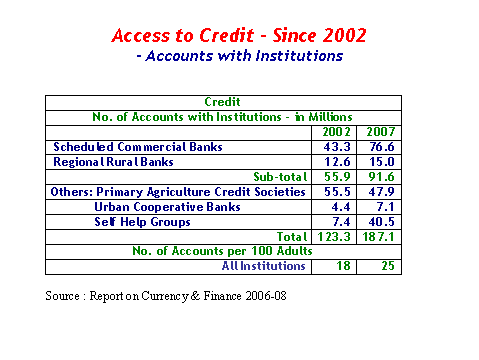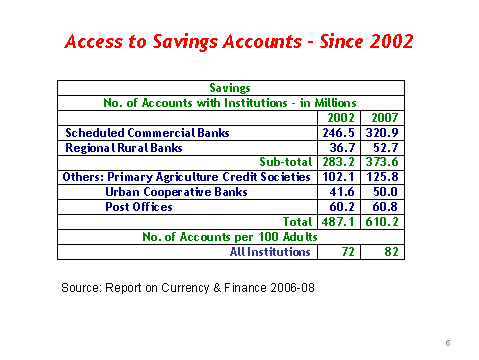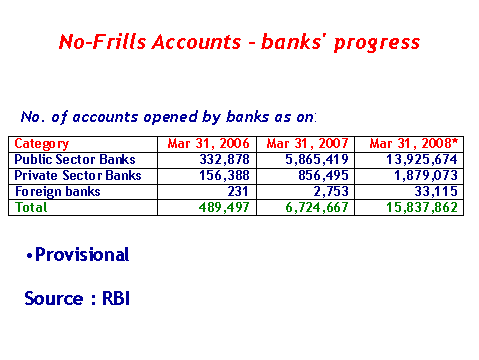 IST,
IST,


Financial Inclusion and Information Technology
Smt. Usha Thorat, Deputy Governor, Reserve Bank of India
delivered-on സെപ്റ്റം 12, 2008
It is indeed very heartening to be here at this WIPRO-NDTV Convergence Conference on ‘Vision 2020 - Indian Financial Services Sector’. I thank the organizers for inviting me here today. Introduction 2. The banking system has grown enormously in the last five years keeping pace with and in some cases leading the country’s remarkable economic growth. Simultaneously, the banking system has improved its strength, efficiency and resilience. There have also been significant improvements in the payments and settlements system and electronic payments and RTGS is now much more in use. IT has played a major role in these achievements. Today banks have centralised operations, more and more banks and branches are moving to CBS , network based computing, new delivery channels such as networked ATMs, internet banking, smart card based products, mobile access etc and are using IT for customer relationship management, customer transaction pattern analysis credit profiling and risk management. 3. At the same time, large number of households continues to be excluded from the formal banking system and as per some recent surveys their share has increased. The extent and reasons for exclusion are many and have been well documented in the Rangarajan Committee (RC) and more recently in the very comprehensive and analytical section on financial inclusion in RBI’s latest Currency and Finance (RCF) released a few days ago. The RCF points out that despite the broad international consensus regarding the importance of access to finance as a crucial poverty alleviation tool, it is estimated that globally over two billion people are currently excluded from access to financial services (United Nations, 2006). Definitional issues 4. No universally accepted definition of financial inclusion is available. Financial inclusion has generally been defined in terms of exclusion from the financial system. Broadly, financial exclusion is construed as the inability to access necessary financial services in an appropriate form due to problems associated with access, conditions, prices, marketing or self-exclusion. The working or operational definitions of financial exclusion generally focus on ownership or access to particular financial products and services. There is no single comprehensive measure that can be used to indicate the extent of financial inclusion across economies. Specific indicators such as number of bank accounts, number of bank branches, that are generally used as measures of financial inclusion, can provide only partial information on the level of financial inclusion in an economy. Measures of financial exclusion 5. Whatever measure one may use for India, it is apparent that the financially excluded constitute a significant share of the population especially amongst the low income groups. Based on the AIDIS 2002 survey, RC showed that 111.5 million households had no access to formal credit. It also showed that 17 million households were indebted to moneylenders. The recent Arjun Sengupta Report on financing enterprises in the unorganized sector has pointed out that only 2.4 million out of 58 million units in this sector (with investment of less than Rs 25000 ) have got credit from commercial banks. The AIDIS 2002 also showed that lower the asset class or income, higher the degree of exclusion. These findings are corroborated by Invest India Incomes and Savings Survey (2007). The survey showed that 32.8% of households had borrowed from institutional sources and 67.2 % had borrowed from non institutional sources. The survey also found that 70 per cent of earners in the annual income bracket of more than Rs.400, 000 borrowed from institutional sources as compared with only 27.5 per cent in the case of earners in the income bracket of less than Rs.50,000 . Causes of increased indebtedness from non institutional sources 6. A very interesting analysis by the RCF shows that the major reason for increase in the overall household debt and the increase in the share of households indebted to non-institutional sources between 1991 and 2002 was a significant increase in current farm expenditure and household expenditure, especially in rural areas. The ‘household expenditure’ includes expenditure incurred on purchase of residential plot; purchase, construction, addition/alteration of building for residential purposes; purchase of durable households assets, clothes, among others and expenditure on medical treatment, education, marriages, and ceremonies. Thus, the ‘household expenditure’ includes many items for which households may find it difficult to obtain loans from institutional sources. The IIMS Survey also suggests that a large portion of loan is taken by the households for meeting financial emergency, medical emergency and social obligations. These three purposes accounted for about 53 per cent of the loans availed of by indebted earners. Furthermore, more than 60 per cent earners, indebted to non-institutional sources, took loans for the aforesaid three purposes. In the case of emergencies, people may find it convenient to approach non-institutional sources for their credit needs. Financial emergencies, for instance, include unplanned expenditure on business, consumption and marriage, among others, which may not be financed by banks and other institutional agencies. 7. Some of the other causes for greater recourse to non institutional sources as identified by the RCF are deceleration in bank credit to households in the context of change in banks’ behaviour in the 1990s due to their impaired balance sheets and tightening of prudential norms and the slowdown in formal credit to households in the context of the slowdown in agriculture and allied activities that may have induced such households to approach non-institutional sources to meet their credit requirements. The RCF has however noted that the last round of NSSO survey related to the year 2002. Subsequently, several policy initiatives have been taken by the Government/Reserve Bank to improve the credit flow to agriculture and the needy sectors. These measures had a significant positive impact on financial inclusion as revealed by the data for subsequent period.
Challenges in achieving FI for inclusive growth 8. Looking at the findings of these surveys and analysis, it is quite clear that financial inclusion has to be an urgent national priority if we are to achieve inclusive growth. The major challenges in banks extending services to the excluded are large costs of covering the huge numbers (cost of enrollment) , relative high maintenance costs for such accounts, small ticket size for each transaction, need for communication modes suited to the illiterate and in local language, affordability of the product or service, need for local acceptance and involvement of locally acceptable personnel, need for large scale coverage including over difficult geographic terrain and areas where there is no electric power or normal telecommunication facilities. Further, as is now very obvious from the recent surveys by AIDIS and IIMS, the challenge also lies in offering to low income households and unorganized enterprises a simple loan product which is not based on or linked to the purpose of the loan, the collateral or assets held or income earned by the household but is purely based on cash flow and credit record of the household. Vision 2020 9. Looking to 2020, it is even more apparent that the task of banking the unbanked will be truly daunting. Nearly 600 million new customers’ accounts will have to be opened and serviced through a variety of channels leveraging on IT. 10. In the Annual Policy for 2005-06 , for the first time the word financial inclusion was used and banks were asked to open “no frills” or a basic banking account to all those desirous of opening a bank account. Several other aspects such as simplified KYC, OTS for loans upto Rs 25000, offering a GCC/simplified overdrafts etc were also covered. A decentralized approach was advocated through targeting 100% financial inclusion district by district involving the DCC and bank and government officials to facilitate enrolment and identification. Another very important policy measure in January 2006 was to allow banks to adopt the agency model or what is known as the Business facilitator /Business Correspondent model for achieving greater outreach through intermediaries /agents. The results have been extremely impressive. In just two years the number of no frills accounts opened by banks has increased from around half a million accounts in March 2006 to 15 million in 2008. Going by the data from service providers offering smart card solutions , it may be assumed that smart card accounts probably account for 2 to 3 million of these no frills accounts. Evaluation by external agencies appointed by RBI has shown that while the first stage of opening no frills accounts has been quite impressive, due to inadequate f follow up, cost of transaction and access constraints, in many cases the accounts have not been operated upon at all after having been opened. In order to improve access and use of these accounts , banks will have to offer the services much closer to the customer either through mobile branches, satellite offices, extension counters or using intermediaries like SHGs/MFIs or through business correspondents using IT to increase scale , access and reduce cost. Also as is obvious from the results of these recent studies and surveys, the credit product that has to be offered, if the low income borrowers have to be brought into the formal system, has to be simple covering all the needs of small borrowers. I have absolutely no doubt that the simple overdraft or GCC based on cash flow/ track record is the way forward to meet the challenges of providing access to the large numbers currently excluded.
SHGs and MFIs role in FI 11. The need for informality in credit delivery and easy access is demonstrated by the fact that SHGs and MFIs constitute the fastest growing segment in recent years in reaching out to small borrowers. These institutions are able to effectively address the small ticket and last mile issues. In the four years between 2003 and 2007, small borrower bank accounts (credit) i.e upto Rs 25000 increased marginally from 36.9 million to 38.6 million, while SHGs’ borrowing members grew from 10 million to 40.5 million and MFIs’ borrowers grew from 1.1 million to 8 million. In 2007-08, MFIs have added 6 million clients increasing their outreach to 14 million as per data brought out by Sa Daan. Role of ICT in FI 12. To be able to ensure that the challenges of banking the unbanked are met effectively and converted into growing and sustainable business for banks, there is no alternative to adoption of ICT solutions on a very large scale and range. ICT solutions are required to capture customer details, facilitate unique identification, ensure reliable and uninterrupted connectivity to remote areas and across multiple channels of delivery, offer multiple financial products (banking, insurance, capital market) through same delivery channel while ensuring consumer protection, develop comprehensive and reliable credit information system so essential for efficient credit delivery and credit pricing, develop appropriate products tailored to local needs and segments, provide customer education and counseling , enable use of multi media and multi -language for dissemination of information and advice. ICT for FI - RBI initiatives 13. I now turn to the specific initiatives of RBI in regard to ICT for Financial Inclusion. The very first initiative was emphasizing the use of IT solutions while adopting the agency or BC model for financial inclusion. A paper placed on the RBI website has envisaged a scheme with RBI support for providing satellite connectivity for remote area branches. The reports of three working groups set up by RBI to consider support to RRBs and UCBs in computerizing their operations and adopt IT solutions for financial inclusion have been placed in public domain for comments. These groups have recommended that the IDRBT could offer interest free loans to UCBs and RRBs for adoption of IT. Based on comments and response RBI will be firming up these schemes. Recognizing the penetration of mobile phones (including amongst the low income population) and the enormous opportunities they offer in extending the banking outreach. RBI had placed a paper on mobile banking in the public domain and the guidelines are now being finalized. The NFS is able to offer nationwide networking of ATMs and can facilitate banking transactions including remittances through ATMs linked to the NFS. Effective from April 1, 2009 a customer will be able to use any ATM (including other bank ATMs) to operate his /her account at no cost. Other initiatives include those aimed at ensuring quicker, safer currency and funds transfer. In fact RBI has put on its web-site yesterday an approach paper on rationalisation of service charges for usage of electronic products, which would facilitate easier movement of funds at lower costs Electronic Benefit Payments 14. Recognising the several advantages of using bank accounts for disbursal of government benefits, many State Governments have decided to disburse NREGA payments social security benefits electronically through no frills bank accounts and in some States with such accounts operated through smart cards with bio–metric identification. A Committee set up by RBI examined the various models through which such payments can be made and has recommended a bank led model with sharing of costs between Government and banks. Appropriate support from the RBI or the Financial Inclusion Technology Fund could also be thought of in the initial stages. Such accounts that have been opened to receive government benefits/payments can become the base for a host of other financial services and facilitate the objective of financial inclusion. Regulatory framework 15. The regulations relating to IT solutions for banking services in general and financial inclusion in particular relate to ensuring integrity of banking system and ensuring customer protection. These cover customer identification/authentication , customer confidentiality/ privacy, KYC/AML issues, outsourcing, bank’s responsibility for their agents, ensuring inter–operability and open standards, imaging standards and adherence to payments system regulations. Way Forward Keynote address on ‘Financial Inclusion and Information Technology’ by Deputy Governor(Smt. Usha Thorat) at ‘Vision 2020 - Indian Financial Services Sector’ hosted by NDTV at The Ballroom, Taj Lands End, Mumbai on 12.09.2008 |
പേജ് അവസാനം അപ്ഡേറ്റ് ചെയ്തത്:




















